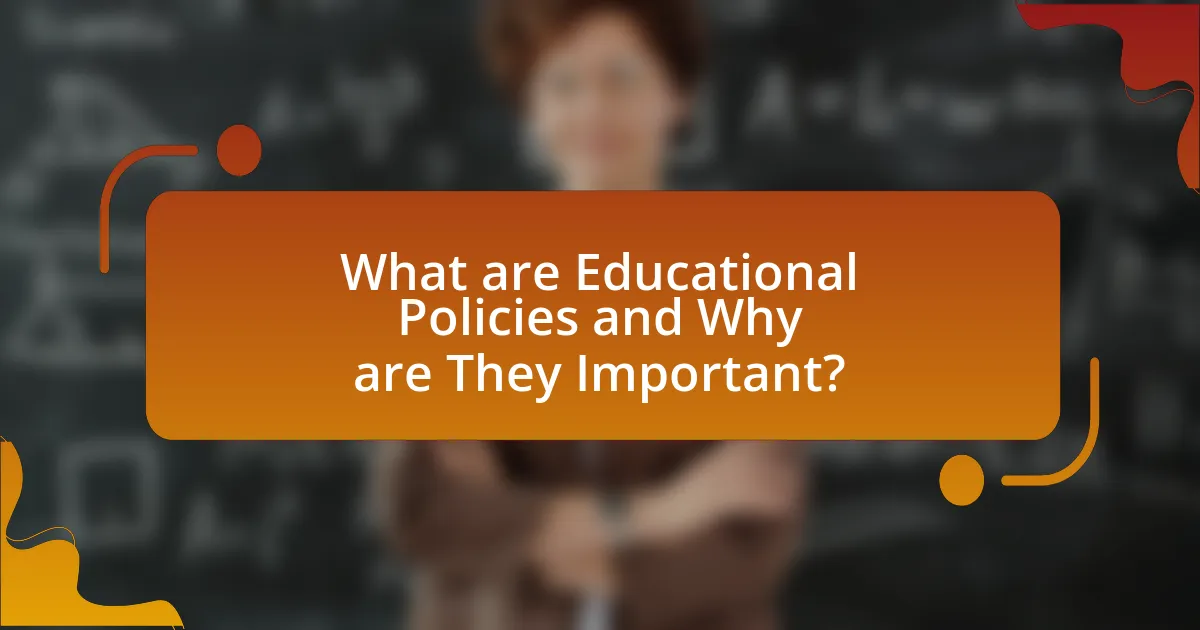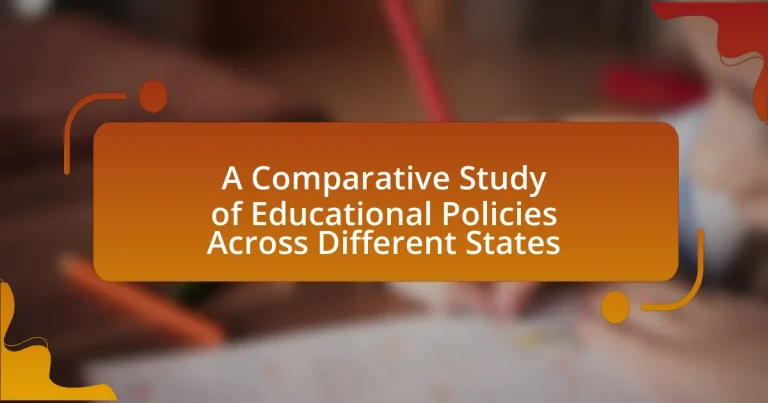The article provides a comparative study of educational policies across different states in the United States, highlighting the formal guidelines that govern educational systems and their impact on curriculum, funding, and assessment methods. It examines how educational policies vary by state, influenced by political, economic, social, and cultural factors, and discusses the implications of demographic differences on policy decisions. Key components of educational policies, such as curriculum standards and funding mechanisms, are analyzed, along with the challenges states face in policy formulation and the role of stakeholders in the reform process. The article also explores recent trends in educational policy reform, including a focus on equity, technology integration, and the need for data-driven decision-making to improve educational outcomes.

What are Educational Policies and Why are They Important?
Educational policies are formal guidelines and regulations that govern the operation and structure of educational systems, influencing curriculum, funding, and assessment methods. They are important because they shape the quality and accessibility of education, directly impacting student outcomes and societal development. For instance, the implementation of the Every Student Succeeds Act in the United States aimed to provide equal educational opportunities and improve accountability in schools, demonstrating how educational policies can drive systemic change and enhance educational equity.
How do educational policies vary across different states?
Educational policies vary significantly across different states in the United States, reflecting diverse priorities and approaches to education. For instance, states like Massachusetts emphasize high academic standards and rigorous testing, while others, such as California, focus on inclusive education and funding for diverse student populations. According to the National Center for Education Statistics, states also differ in their funding mechanisms, with some relying heavily on local property taxes, which can create disparities in educational resources. Additionally, policies regarding curriculum standards, teacher certification, and school choice options, such as charter schools and vouchers, further illustrate the variation among states. These differences are shaped by local governance structures, demographic factors, and political ideologies, leading to a complex landscape of educational policy across the nation.
What factors influence the development of educational policies in each state?
The development of educational policies in each state is influenced by a combination of political, economic, social, and cultural factors. Political factors include the priorities of state legislators and governors, which can shape funding and regulatory frameworks. Economic factors involve the availability of state resources and funding levels, impacting the implementation of educational programs. Social factors encompass demographic trends, public opinion, and community needs, which can drive policy changes to address equity and access in education. Cultural factors reflect the values and beliefs of the population, influencing curriculum choices and educational standards. For instance, states with diverse populations may adopt policies that promote multicultural education to reflect their communities.
How do state demographics impact educational policy decisions?
State demographics significantly influence educational policy decisions by shaping priorities, resource allocation, and program development. For instance, states with higher populations of low-income families may prioritize funding for free or reduced-price lunch programs and after-school initiatives to support student needs. Additionally, demographic factors such as racial and ethnic diversity can lead to policies aimed at promoting equity and inclusion, such as bilingual education programs in states with substantial non-English speaking populations. Research from the National Center for Education Statistics indicates that states with larger minority populations often implement policies focused on closing achievement gaps, reflecting the demographic realities of their student populations.
What are the key components of educational policies?
The key components of educational policies include curriculum standards, funding mechanisms, teacher qualifications, assessment and accountability systems, and access to education. Curriculum standards define what students are expected to learn, while funding mechanisms determine the financial resources allocated to schools. Teacher qualifications ensure educators meet specific criteria for effective teaching, and assessment and accountability systems evaluate student performance and school effectiveness. Access to education addresses equity and inclusion, ensuring all students have the opportunity to receive quality education. These components are essential for shaping educational outcomes and are often influenced by state and federal regulations.
What role do curriculum standards play in educational policies?
Curriculum standards serve as a foundational framework that guides educational policies by establishing clear expectations for what students should learn at each grade level. These standards ensure consistency and quality across educational systems, enabling states to align their curricula with desired educational outcomes. For instance, the Common Core State Standards, adopted by multiple states, aim to provide a unified set of learning goals in mathematics and English language arts, facilitating comparability in student performance across state lines. This alignment helps policymakers assess educational effectiveness and allocate resources more efficiently, ultimately aiming to improve student achievement and prepare learners for college and careers.
How do funding mechanisms affect educational policy implementation?
Funding mechanisms significantly influence educational policy implementation by determining the resources available for schools and programs. For instance, states that allocate more funding to education often see better implementation of policies aimed at improving student outcomes, as evidenced by the correlation between increased funding and higher graduation rates in various districts. Research from the National Center for Education Statistics indicates that districts with higher per-pupil spending tend to have more comprehensive educational programs and better teacher retention rates, which are critical for effective policy execution. Thus, the structure and amount of funding directly impact the capacity of educational institutions to implement policies effectively.
What challenges do states face in formulating educational policies?
States face several challenges in formulating educational policies, including budget constraints, varying stakeholder interests, and differing educational standards. Budget constraints limit the resources available for implementing comprehensive educational reforms, often resulting in inadequate funding for essential programs. Additionally, states must navigate the diverse interests of stakeholders, such as parents, teachers, and policymakers, which can lead to conflicting priorities and hinder consensus on policy direction. Furthermore, the lack of uniform educational standards across states complicates the development of cohesive policies, as states may struggle to align their objectives with national benchmarks or best practices. These challenges collectively impede the effective formulation and implementation of educational policies.
How do political climates influence educational policy changes?
Political climates significantly influence educational policy changes by shaping the priorities and funding allocations of government entities. For instance, during periods of conservative governance, there is often a push for policies that emphasize standardized testing and school choice, as seen in states like Florida under Governor Ron DeSantis, where legislation has favored charter schools and voucher programs. Conversely, liberal administrations tend to advocate for increased funding for public schools and initiatives aimed at reducing educational inequality, as evidenced by policies implemented in California under Governor Gavin Newsom, which focus on expanding access to early childhood education and increasing teacher salaries. These shifts in policy reflect the broader ideological beliefs of the ruling political party, impacting curriculum standards, teacher training, and resource distribution across states.
What are the implications of socioeconomic disparities on educational policies?
Socioeconomic disparities significantly influence educational policies by creating unequal access to resources and opportunities for students. These disparities often lead to policies that prioritize funding for schools in affluent areas, resulting in a lack of support for underfunded schools in low-income communities. For instance, research from the National Center for Education Statistics indicates that schools in high-poverty areas receive about $1,000 less per student compared to those in wealthier districts. This funding gap affects teacher quality, class sizes, and availability of advanced coursework, ultimately impacting student outcomes and perpetuating cycles of poverty. Consequently, educational policies must address these disparities to ensure equitable access to quality education for all students, regardless of their socioeconomic status.

How do Different States Approach Educational Equity?
Different states approach educational equity through various policies and funding mechanisms aimed at addressing disparities in educational access and resources. For instance, California has implemented the Local Control Funding Formula, which allocates additional funds to schools serving low-income students and English learners, thereby promoting equity in education. In contrast, Texas utilizes a system of property tax-based funding, which often results in significant disparities between wealthy and less affluent districts, highlighting a less equitable approach. Research indicates that states with targeted funding strategies, like Massachusetts, which invests heavily in early childhood education and support services, tend to achieve better educational outcomes for disadvantaged populations. These examples illustrate the diverse methodologies states employ to tackle educational equity, reflecting their unique socio-economic contexts and policy priorities.
What strategies are employed to promote educational equity across states?
Strategies employed to promote educational equity across states include targeted funding initiatives, equitable resource allocation, and inclusive policy frameworks. Targeted funding initiatives, such as Title I funding in the United States, provide additional financial resources to schools serving low-income students, thereby addressing disparities in educational opportunities. Equitable resource allocation ensures that schools in underfunded areas receive necessary materials, technology, and qualified teachers, which is critical for fostering an environment conducive to learning. Inclusive policy frameworks, such as those promoting culturally relevant curricula and anti-discrimination measures, further support educational equity by recognizing and addressing the diverse needs of all students. These strategies collectively aim to reduce achievement gaps and ensure that every student has access to quality education, regardless of their socioeconomic status or geographic location.
How do states address the needs of marginalized communities in their policies?
States address the needs of marginalized communities in their policies by implementing targeted educational programs and funding initiatives that aim to reduce disparities. For example, many states have adopted policies that allocate additional resources to schools in low-income areas, ensuring access to quality education for underrepresented groups. According to the National Center for Education Statistics, states that have enacted equitable funding formulas have seen improvements in educational outcomes for marginalized students, demonstrating the effectiveness of such policies. Additionally, states often engage in community consultations to better understand the specific needs of these populations, allowing for more tailored and effective policy responses.
What role does federal funding play in supporting educational equity initiatives?
Federal funding plays a crucial role in supporting educational equity initiatives by providing financial resources aimed at reducing disparities in educational access and quality. This funding is often allocated through programs such as Title I, which specifically targets schools with high percentages of low-income students, ensuring they receive additional support to improve educational outcomes. For instance, in the 2020 fiscal year, Title I funding amounted to approximately $15.8 billion, directly benefiting millions of students in under-resourced schools. Such federal investments are essential for implementing programs that address inequities, such as enhanced teacher training, access to advanced coursework, and improved facilities, thereby fostering a more equitable educational landscape across states.
How do states measure the effectiveness of their educational policies?
States measure the effectiveness of their educational policies primarily through standardized testing and performance metrics. These assessments provide quantifiable data on student achievement, allowing states to evaluate the impact of their policies on educational outcomes. For instance, the National Assessment of Educational Progress (NAEP) serves as a benchmark for comparing student performance across states, revealing disparities and areas for improvement. Additionally, states analyze graduation rates, college enrollment statistics, and post-secondary success to gauge the long-term effectiveness of their educational strategies. This data-driven approach enables policymakers to make informed decisions and adjustments to enhance educational quality.
What metrics are commonly used to evaluate educational outcomes?
Common metrics used to evaluate educational outcomes include standardized test scores, graduation rates, and student attendance rates. Standardized test scores provide a quantifiable measure of student learning and achievement across various subjects, allowing for comparisons between different schools and districts. Graduation rates indicate the percentage of students who complete their education within a specified timeframe, reflecting the effectiveness of educational programs. Student attendance rates serve as an indicator of engagement and participation, which are critical for successful learning outcomes. These metrics are widely recognized in educational research and policy analysis, as they offer concrete data for assessing the performance of educational systems.
How do states adjust policies based on evaluation results?
States adjust policies based on evaluation results by analyzing data from assessments and feedback mechanisms to identify areas needing improvement. For instance, when student performance metrics indicate low achievement in specific subjects, states may revise curriculum standards or allocate additional resources to those areas. A concrete example is the implementation of the Every Student Succeeds Act (ESSA), which requires states to use data-driven evaluations to inform educational strategies and interventions. This approach ensures that policy adjustments are grounded in empirical evidence, leading to more effective educational outcomes.

What are the Trends in Educational Policy Reform?
Trends in educational policy reform include increased emphasis on equity, accountability, and technology integration. Recent reforms focus on closing achievement gaps among diverse student populations, driven by data that shows persistent disparities in educational outcomes. For instance, the Every Student Succeeds Act (ESSA) of 2015 shifted accountability measures to prioritize student performance and equity, allowing states to develop their own plans to address these issues. Additionally, the integration of technology in classrooms has accelerated, particularly due to the COVID-19 pandemic, which highlighted the need for digital learning tools and resources. Research indicates that states adopting comprehensive technology policies have seen improved student engagement and learning outcomes.
What recent reforms have been implemented in various states?
Recent reforms in various states include the implementation of universal pre-kindergarten programs, increased funding for K-12 education, and the adoption of new curriculum standards focused on STEM education. For instance, New York has expanded its pre-kindergarten initiative to cover more children, while California has allocated additional resources to improve teacher salaries and reduce class sizes. Additionally, states like Texas have revised their science and math curricula to enhance student engagement and performance in these critical areas. These reforms aim to improve educational outcomes and address disparities in access to quality education across different regions.
How have technology and innovation influenced educational policy reforms?
Technology and innovation have significantly influenced educational policy reforms by enabling personalized learning, improving access to resources, and facilitating data-driven decision-making. For instance, the integration of digital tools in classrooms has led to policies that promote blended learning environments, which cater to diverse learning styles and needs. According to a report by the U.S. Department of Education, schools that adopted technology-enhanced learning saw a 20% increase in student engagement and achievement. Furthermore, innovations such as online assessments and learning management systems have prompted reforms that emphasize accountability and performance metrics, ensuring that educational outcomes are measurable and transparent. These shifts reflect a broader trend where technology not only enhances educational delivery but also shapes the frameworks within which educational policies are developed and implemented.
What role do stakeholders play in the reform process?
Stakeholders play a crucial role in the reform process by influencing decision-making, providing resources, and ensuring accountability. Their involvement can shape educational policies through advocacy, feedback, and collaboration with policymakers. For instance, research indicates that stakeholder engagement leads to more effective reforms, as seen in the implementation of the Every Student Succeeds Act, where input from teachers, parents, and community members significantly impacted state-level educational strategies. This demonstrates that active participation of stakeholders not only enhances the relevance of reforms but also fosters a sense of ownership and commitment to the educational changes being pursued.
What lessons can be learned from successful educational policies in different states?
Successful educational policies in different states demonstrate the importance of data-driven decision-making, equitable funding, and community engagement. For instance, Massachusetts has consistently ranked high in educational outcomes due to its focus on rigorous standards and accountability measures, which are supported by comprehensive data analysis. Additionally, states like Florida have shown that targeted investments in early childhood education can lead to significant long-term academic improvements, evidenced by increased third-grade reading proficiency rates. Furthermore, the involvement of parents and local communities in policy formulation, as seen in California’s Local Control Funding Formula, has led to more tailored educational solutions that address specific community needs. These examples illustrate that effective educational policies are characterized by a combination of accountability, targeted funding, and community collaboration.
How can best practices from one state be adapted to another?
Best practices from one state can be adapted to another by conducting a thorough analysis of the contextual differences, including demographics, funding structures, and existing educational frameworks. This process involves identifying successful strategies implemented in one state, such as innovative teaching methods or effective resource allocation, and assessing their relevance and feasibility in the target state’s unique environment. For instance, the implementation of a successful literacy program in one state can be adapted by modifying its curriculum to align with local educational standards and cultural contexts, ensuring that it meets the specific needs of students in the new setting. Research indicates that states that customize best practices based on local conditions, such as the study by the Education Commission of the States, show improved educational outcomes, demonstrating the effectiveness of this adaptive approach.
What common pitfalls should states avoid in policy development?
States should avoid the common pitfalls of insufficient stakeholder engagement, lack of data-driven decision-making, and failure to consider long-term impacts in policy development. Insufficient stakeholder engagement can lead to policies that do not reflect the needs and perspectives of the community, resulting in ineffective implementation. Lack of data-driven decision-making often results in policies based on assumptions rather than evidence, which can lead to poor outcomes; for instance, a study by the National Center for Education Statistics found that data-informed policies significantly improve educational performance. Additionally, failure to consider long-term impacts can result in short-sighted policies that do not address underlying issues, as seen in various states where temporary fixes led to recurring problems in educational systems.
What are the future directions for educational policies across states?
Future directions for educational policies across states include a focus on equity in funding, integration of technology in classrooms, and the promotion of social-emotional learning. States are increasingly prioritizing equitable funding models to address disparities in educational resources, as evidenced by initiatives like California’s Local Control Funding Formula, which allocates more resources to disadvantaged students. Additionally, the integration of technology is being emphasized to enhance learning experiences, with states investing in digital infrastructure and training for educators. Furthermore, social-emotional learning is gaining traction, with research indicating that such programs can improve student outcomes and well-being, prompting states to incorporate these frameworks into their curricula.
How might changing demographics shape future educational policies?
Changing demographics will significantly shape future educational policies by necessitating tailored approaches to meet the diverse needs of students. As populations become more multicultural and include varying socioeconomic backgrounds, educational policies must adapt to ensure equity in access and resources. For instance, the U.S. Census Bureau projects that by 2045, the majority of the U.S. population will be composed of racial and ethnic minorities, which indicates a need for policies that promote inclusivity and culturally relevant curricula. Additionally, research from the National Center for Education Statistics shows that schools with higher percentages of minority students often face funding disparities, highlighting the necessity for policy reforms aimed at equitable resource distribution. Thus, changing demographics will drive educational policymakers to prioritize diversity, equity, and inclusion in their strategies.
What emerging trends should policymakers be aware of?
Policymakers should be aware of the increasing integration of technology in education, particularly through online learning platforms and digital resources. This trend is evidenced by the rapid growth of remote learning solutions, which saw a 300% increase in usage during the COVID-19 pandemic, highlighting the necessity for adaptable educational policies that accommodate diverse learning environments. Additionally, there is a growing emphasis on personalized learning, supported by data analytics, which allows for tailored educational experiences that meet individual student needs. This shift is backed by research from the Bill & Melinda Gates Foundation, indicating that personalized learning can significantly improve student outcomes.
What practical steps can states take to improve their educational policies?
States can improve their educational policies by implementing evidence-based practices, increasing funding for education, and enhancing teacher training programs. Evidence-based practices, such as adopting curricula that have been proven effective through research, can lead to better student outcomes. For instance, the Institute of Education Sciences reports that schools using evidence-based interventions see significant improvements in student performance. Increasing funding allows for better resources, smaller class sizes, and more support staff, which are critical for effective learning environments. According to the National Center for Education Statistics, states that invest more in education tend to have higher graduation rates. Finally, enhancing teacher training programs ensures that educators are equipped with the latest pedagogical strategies and knowledge, which directly impacts student learning. Research from the National Council on Teacher Quality indicates that states with robust teacher preparation programs have higher student achievement levels.


